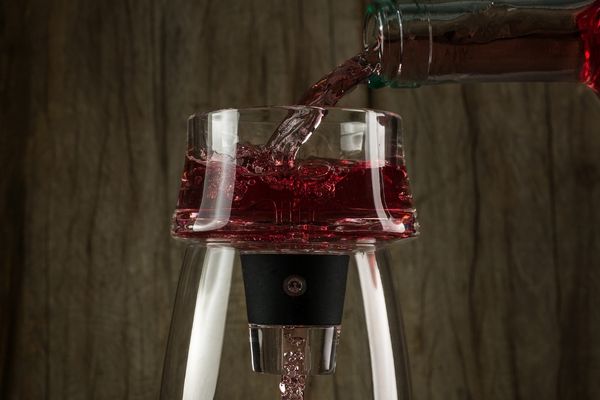Must Read Tips: How Long Should You Let Wine Breathe?
The pizza just arrived. You haven’t chosen a wine from your stash let alone thought about letting your beautiful wine breathe.
You’ve heard of letting wine breathe but maybe you’re not sure what that means. You’re probably wondering how long you should let your wine breathe?
You may even have come across some self-proclaiming Youtube wino pouring perfectly good wine into a blender.
Now, letting wine breathe is certainly important – but I don’t think that’s how the winemakers of history did it… Also, don’t do that.
Anyway, we’re breaking down the why, the how, and the what when it comes to letting wine breathe.
We’ll share how long to let your red wine breathe, how to let your white wine and breathe and if you should let your sparkling wine breathe.
We’ll also throw out a couple vocabulary terms that’ll help you sound like a pro at your next wine dinner!
But ultimately, these techniques aren’t about being wine-fancy. It’s all about enjoying more of the flavors that are in your glass.

What Does “How To Let Wine Breathe” Mean?
To let wine breathe means to allow wine to be exposed to oxygen as it is being poured out of the bottle.
This process will “open up” a wine, releasing flavors and aromas that sometimes get locked into a wine that’s been in bottle for a long time.
Now, almost every style of wine can benefit from being aerated, with some needing it more than others. Most notably, young tannic reds will soften if aerated, while old tannic reds will open up and unlock sleepy flavors.
The process of aerating won’t work by simply uncorking the wine and letting it sit out, although you may notice a difference in the taste of a wine between the day you opened it and the second or third day.
Oxygenation does happen after uncorking a wine, but it’s a slow process.
In order to get the full benefit the same day you open the wine, you really need a wider surface area. This can be done through wine accessories, which we’ll discuss down below.
Which Wines Should I Aerate And For How Long?

As we mentioned, nearly all wines benefit from being aerated. The amount of time is relative, and is by no means a science.
Young Bold Tannic Reds (ex. Cabernet Sauvignon, Shiraz, Merlot, Malbec)- Should be aerated to soften harsh tannins for 15-30 minutes.
Old Reds with High Tannins (ex. Cabernet Sauvignon, Nebbiolo)- Should be tasted first and possibly aerated if the wine seems “tight” or inexpressive, like something is missing. If the wine seems tight, aerate it for around 10 minutes.
Old Reds with Low Tannins (ex. Pinot Noir, Red Burgundy, Chianti Classico)- Should not be aerated at all, as they will immediately lose their delicate flavor.
Sparkling Wines (ex. Champagne, Cava, Prosecco)- Should not be aerated, as this will destroy delicate bubbles.
Young White Wines (ex. Sauvignon Blanc, Chablis)- Can benefit from 10-20 minutes of aeration, especially if the wine tastes reductive (think sulfur, rotten eggs or matchstick aroma.)
Older White Wines (ex. White Burgundy, Older White Bordeaux)- Similar rules to older red wines, avoid aerating lighter aromatic whites for long, as that could ruin delicate flavors.
White wines that have a bigger backbone such as Chardonnay can benefit from 10 minutes or so of aeration.
how to Aerate your wine

There are an endless amount of wine accessories you can buy that claim to do the job. Here’s a breakdown of some of your options:
Decanter
Decanting your wine is great because decanters create a wide surface area and the shape exposes the wine to oxygen as it’s being poured. They also look cool on the table. This is the decanter we gave to a lucky winner in our most recent giveaway.
Aerator Pourer
Aerators are pourers that you attach to the bottle that swirl the wine around before it makes its way into your glass. These are helpful, but they won’t do the entire job in the few seconds it takes to pour wine through them.
You’re still better off letting your wine rest in the glass for a while before drinking.
This cheap little guy does the job. You can buy a fancy one to impress friends but this one works just fine.
Blending
Perhaps you’ve seen a YouTuber or Tik Toker claim that this is a fantastic way to open the wine really quickly…
Those of us over at Armchair Somm remain to be convinced. We believe this is more likely to destroy any delicacy the wine has.
Also, I don’t know about you, but I wouldn’t want to pour an expensive wine into the same container I make smoothies in.
Pouring Wine Between Two Containers
Pouring wine between two containers works well, as it incorporates a lot of oxygen in a short amount of time, without blending the crap out of the wine.
However, this also takes up your time and requires two pieces of equipment (or two mason jars).
Swirling in a Glass
Swirling wine in your glass is the cheapest and most tried-and-true way to guarantee your wine gets exposed to oxygen.
This simple solution can be combined with an aerator pourer or a decanter, and gives the added benefit of bringing the wine close to you to pick up on those beautiful aromas.
The only downside is if you want your wine to aerate for over 10 minutes, that’s a lot of swirling! That’s why I recommend starting your wine in a decanter, then pouring it into your glass and swirling until you’re satisfied, or thirsty!
How To Swirl Your Wine
Swirling wine is a skill that’s not as easy as it looks. To properly swirl your wine, pour it into your glass, making sure not to fill it too high that the wine will slosh out.
Next, start by keeping your glass on a table and moving your hand in a counterclockwise circle. Start slowly and work your speed up. It may take a couple tries, but eventually you’ll get the hang of it.
Eventually, try doing the same thing with your glass off the table.
What’s The Difference Between Aeration And Decanting

I want to clarify the difference between aeration and decanting. To “aerate” a wine is to expose it to oxygen.
You can use a decanter to do this… but to “decant” a wine is a different process, one that you also need a decanter to do.
To decant a wine is to pour the wine into a container, leaving behind sediment that gathers at the bottom of the bottle. This is done for old Ports or deeply colored, older Cabernets or Bordeauxs.
This sediment is not bad for you, it’s just unpleasant to drink. They’re formed by chain molecules of color and tannin that every old bottle of red wine will get eventually.
How To Decant A Wine

- Leave the bottle upright for a day or two before you want to drink it. This will cause sediment to gather at the bottom.
- Slowly remove the cork without jostling the wine.
- Pour your wine at an angle into a decanter, watching carefully to make sure sediment stays in the bottle
Once you’ve rescued as much of the wine as you can without introducing sediment into the decanter, enjoy it!
Final Thoughts To How Long You Should Let Wine Breathe
I encourage you to experiment by opening a bottle of wine and tasting it right away, versus after some aeration. I guarantee you will notice a difference.
Lastly, always remember that at the end of the day, drinking wine should be fun and never stressful!

More Decanters and Aerators
Calling all brand snobs! Looking for brand recognition? Impress the wine lover in your life with a machine-blown crystal Cabernet Riedel Decanter.
Le Chateau Red Wine Decanter Aerator
If you dread dripping wine from your decanter this crystal wine decanter’s easy to pour slanted spout, eliminates wine spills and drips.
Give ‘em a show with a swan crystal decanter. This beautiful hand blown crystal decanter will look great on any bar.
Electric Wine Opener, Aerator, Foil Cutter, Vacuum Stopper
This complete set makes a great gift or just another fun tool to have at your bar. It has all the goodies to open your bottle and store it. Foil cutter, electric opener, aerator and pourer, 2 vacuum stoppers all on a display charging base.
FAQ- How Long Should You Let Wine Breathe?
Can wine breathe too long?
Older vintage wines may be ready right out of the bottle.
There’s a common misconception that older wines all require several hours of decanting. The truth is, even several minutes in a decanter may overly oxidize an older, delicate wine.
Should you let all wine breathe?
It opens the tightness of the wine to let more characteristics show through. If it is a young wine, a longer time exposed to air will help open it up to show more complexity and soften the tannins. If it is an older wine, a little time exposed to air will wake it up from its long sleep to awaken its liveliness.
What happens if you don’t let wine breathe?
Some wines benefit from the changes in flavor and aroma from oxidation. This process can soften tannins and can bring out fruity and nutty aspects. Yet, too much oxidation ruins any wine. The combination of diminished flavor, aroma, and color is called flattening. Not good.
How do you know when wine needs to breathe?
If your mouth tingles all over and the wine is slightly bitter, maybe it seems tight, and you can’t really taste much else, it needs to breathe.









